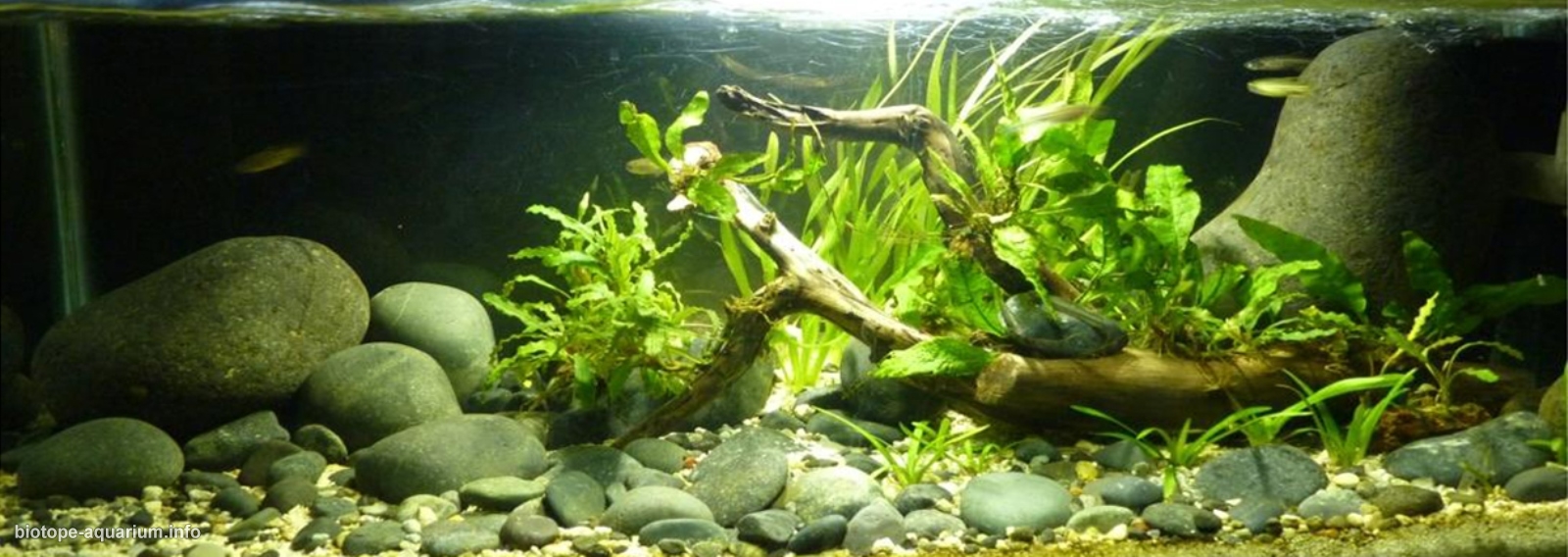Main River Bengal Assam Border, India
_th place in Biotope Aquarium Design Contest 2020

Volume: 35 liters
Dimensions: 60x25x23cm
List of fishes: Brachydanio frankei
List of plants: Vallisneria sp.
Local epiphyte plant
Description of decorations: In this aquarium the pebbles, rocks and sand were all collected in the river. The shape and color of the selected pebbles, rocks, sands are basiclly the same as the habitat. I used rocks and sands of different size to immitate the hidden place in the habitat for B. frankei. The addition of plants (Valiisneria sp.) to diffuse the light entering the tank. The driftwood is very common in the river adds a natural feel. Brachydanio frankei really need to be kept in group to feel comfortable and showing their natural behaviour. The B. frankei able to swim very fast. It is active in nature and always moving. I designed water flow in the tank just like the habitat and make large swimming area. So this fish can swim in this tank in the same way as they do in the nature.
Description of equipment: Takari Power Headpump 1000 lph, LED lamp 3 watt
Water parameters: Temperature : 27-28 C,
pH : 7.2
KH : 8-12
Hardness range : 4-12 dGH
Additional info: Water change : At least 25-50% of the tank water should be replace once a month.
Food and Feeding : B. frankei enjoy chasing after frozen bloodworms. A balanced diet for them would include flake or pelleted foods, plant based food, and occasional live pray. As with all danios, these fish are active and have high nutrient requirements, so select food that will provide for their needs. These fish feeding several times a day.
INFORMATION ABOUT BIOTOPE:
Description of the area surrounding the biotope: Brachydanio frankei is a color variation of the Danio reiro. Natives to the Ganges region in eastern India, these fish are found in variety of habitats, ranging from fast moving streams to slow moving nearly stagnant ponds. Agriculture, industry, modern fishing methods involving industrial reagents and other form of habitat degradation may also have adversely affected its range. This area is subjected to seasonal rainfall between the months of June until September due to the southwestern summer mansoon meaning habitat vary considerably depending on the time of year. During the wet season, they are found in large number in seasonal pools and rices paddies where they feed and spawn. Then the adults migrate back to faster moving waters and the young follow when they reach maturity.
Description of the underwater landscape of the biotope: The river passes through sand, it has variety of stones in shapes and colors. The substrate of the clear, freshwater stream is normally rocky and shaded, while the still water are silty with dense vegetation. The most common substrate type was silt, submerged/overhanging vegetation was typical and generally the fish were more abundant in marginal/seasonally-inundated pools and mature rice paddies than stream or river channels. When they were observed in flowing streams with rocky substrates they tended to school in marginal zones with overhanging vegetation. The water in most habitats was clear or relativrly clear, only occasionally turbid. Water flow in the river ranging fast moving stream to slow moving. In the wild, these fish are considered micopredators and feed on worms, small acuatiq crustatcea, insects and insects larvae.
Description of the parameters of the habitat: Water is transparent. The average temperature is 18-23 C. pH Varies from 6.5 -7.5 depending on the season. Have Hardness range 2-20 dGH and KH is 8-12.
List of fishes and invertebrates occurring in the nature biotope: Food : Worm, small acuatiq crustaceas, insect, larva insect.
Parasit : Pseudocapillaria tementosa, Pseudoloma neurophilla, Pleisthopora hypessobryconis
Competitor : Danio dangila, Aplocheilus panchax, genus Esomus, Puntius, Oryzas
Predator : Chana striata, Xenentodon cancila
List of plants found in the nature biotope: In general, the vegetation of the river are primarly tropical type that cover large areas and embrace evergreen, semiever green, decidious forests and grass land.
Threats to the ecology: Agriculture, industry, modern fishing methods involving industrial reagent and other form can affecting habitat of Brachydanio and other fish.
Sources of information:
https://www.seriouslyfish.com/
https://en.wikipedia.org/wiki/
https://www.encyclo-fish.com/
